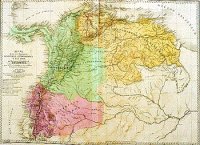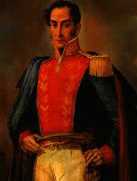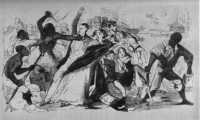
History:
|
|
|
|
History: |
|
|
In Spain Bourbon kings replaced the Hapsburgs in 1700,
and some liberalization of trade was introduced. These
measures were too late for Panama, however. 's
desperate efforts to maintain its colonial trade monopoly
had been self-defeating. Cheaper goods supplied by
England, France, and the Netherlands were welcomed by
colonial officials and private traders alike. Dealing in
contraband increased to the detriment of official trade.
Fewer merchants came to the Portobelo feria to pay
Spain's inflated prices because the foreign suppliers
furnished cheaper goods at any port at which they could
slip by or bribe the coastal guards. The situation
worsened; only five of the previously annual fleets were
dispatched to Latin America between 1715 and 1736, a
circumstance that increased contraband operations. Panama's temporary loss of its independent audiencia, from 1718 to 1722, and the country's attachment to the Viceroyalty of Peru were probably engineered by powerful Peruvian merchants. They resented the venality of Panamanian officials and their ineffectiveness in suppressing the pirates (outlaws of no flag, as distinct from the buccaneers of the seventeenth century). Panama's weakness was further shown by its inability to protect itself against an invasion by the Miskito Indians of Nicaragua, who attacked from Laguna de Chiriquí. Another Indian uprising in the valley of the Río Tuira caused the whites to abandon the Darién. The final blow to Panama's shrinking control of the transit trade between Latin America and Spain came before the mid-eighteenth century. As a provision of the Treaty of Utrecht at the end of the War of the Spanish Succession in 1713, Britain secured the right to supply African slaves to the Spanish colonies (4,800 a year for 30 years) and also to send 1 ship a year to Portobelo. The slave trade provision evidently satisfied both countries, but the trade in goods did not. Smuggling by British ships continued, and a highly organized contraband trade based in Jamaica -- with the collusion of Panamanian merchants-- nearly wiped out the legal trade. By 1739 the importance of the isthmus to Spain had seriously declined; Spain again suppressed Panama's autonomy by making the region part of the Viceroyalty of New Granada (encompassing present-day Colombia, Venezula, Ecuador, and Panama). In the same year, war broke out between Britain and Spain. A British military force took Portobelo and destroyed it. Panamanian historians maintain that this attack diverted Spanish trade from the trans-isthmian route. The Seville-Cádiz monopoly of colonial trade had been breached by royal decrees earlier in the century, and precedent was thus furnished for the merchants of the Latin American colonies to agitate for direct trade with Spain and for intercolonial trade. After 1740 the Pacific coast ports were permitted to trade directly via ships rounding Cape Horn, and the Portobelo feria was never held again. Panama's
economic decline |
|
 Map of Gran Colombia |
Panama thus became part
of Colombia, then governed under the 1821 Constitution of
Cúcuta, and was designated a department with two
provinces, Panamá and Veraguas. With the addition of
Ecuador to the liberated area, the whole country became
known as Gran Colombia. Panama sent a force of 700 men to
join Bolívar in Peru, where the war of liberation
continued. The termination of hostilities against the royalists in 1824 failed to bring tranquillity to Gran Colombia. The constitution that Bolívar had drafted for Bolivia was put forward by him to be adopted in Gran Colombia. The country was divided principally over the proposal that a president would serve for life. The president would not be responsible to the legislature and would have power to select his vice president. Other provisions, generally centralist in their tendencies, were repugnant to some, while a few desired a monarchy. Panama escaped armed violence over the constitutional question but joined other regions in petitioning Bolívar to assume dictatorial powers until a convention could meet. Panama announced its union with Gran Colombia as a "Hanseatic State," i.e., as an autonomous area with special trading privileges until the convention was held. |
|
 Simon Bolívar "No me es posible expresar el sentimiento de gozo y admiración que he experimentado al saber que Panamá, el centro del Universo, es segregado por sí mismo, y libre por su propia virtud. El Acta de la Independencia de Panamá es el documento más glorioso que puede ofrecer a la historia ninguna provincia americana". SIMON BOLIVAR Carta al Coronel JOSE DE FABREGA 1 de febrero de 1822. |
In 1826
Bolívar honored Panama when he chose it as the site for
a congress of the recently liberated Spanish colonies.
Many leaders of the revolutions in Latin America
considered the establishment of a single government for
the former Spanish colonies the natural follow-up to
driving out the peninsulares. Both José de San Martin
and Miranda proposed creating a single vast monarchy
ruled by an emperor descended from the Incas. Bolívar,
however, was the one who made the most serious attempt to
unite the Spanish American republics. Although the league or confederation envisioned by Bolívar was to foster the blessings of liberty and justice, a primary purpose was to secure the independence of the former colonies from renewed attacks by Spain and its allies. In this endeavor Bolívar sought Britain's protection. He was reluctant to invite representatives of the United States, even as observers, to the congress of plenipotentiaries lest their collaboration compromise the league's position with the British. Furthermore, Bolívar felt that the neutrality of the United States in the war between Spain and its former colonies would make its representation inappropriate. In addition, slavery in the United States would be an obstacle in discussing the abolition of the African slave trade. Bolívar nevertheless acquiesced when the governments of Colombia, Mexico, and Central America (see Glossary) invited the United States to send observers. Despite the sweeping implications of the Monroe Doctrine, President John Quincy Adams--in deciding to send delegates to the Panama conference--was not disposed to obligate the United States to defend its southern neighbors. Adams instructed his delegates to refrain from participating in deliberations concerning regional security and to emphasize discussions of maritime neutrality and commerce. Nevertheless, many members of the United States Congress opposed participation under any conditions. By the time participation was approved, the delegation had no time to reach the conference. The British and Dutch sent unofficial representatives. The Congress of Panama, which convened in June and adjourned in July of 1826, was attended by four American states--Mexico, Central America, Colombia, and Peru. The "Treaty of Union, League, and Perpetual Confederation" drawn up at that congress would have bound all parties to mutual defense and to the peaceful settlement of disputes. Furthermore, because some feared that monarchical elements sympathetic to Spain and its allies might regain control of one of the new republics, the treaty included a provision that if a member state substantially changed its form of government, it would be excluded from the confederation and could be readmitted only with the unanimous consent of all other members. The treaty was ratified only by Colombia and never became effective. Bolívar, having made several futile attempts to establish lesser federations, declared shortly before his death in 1830 that "America is ungovernable; those who served the revolution have plowed the sea." Despite his disillusion, however, he did not see United States protection as a substitute for collective security arrangements among the Spanish-speaking states. In fact, he is credited with having said, "The United States seems destined by Providence to plague America with misery in the name of Liberty." Three abortive attempts to separate the isthmus from Colombia occurred between 1830 and 1840. The first was undertaken by an acting governor of Panama who opposed the policies of the president, but the Panamanian leader reincorporated the department of Panama at the urging of Bolívar, then on his deathbed. The second attempted separation was the scheme of an unpopular dictator, who was soon deposed and executed. The third secession, a response to civil war in Colombia, was declared by a popular assembly, but reintegration took place a year later. |
|
 A Fortyniner "The eastern sky is blushing red, The distant hill-top glowing, The river o'er its rocky bed In idle frolic flowing. 'Tis time the pic-axe and the spade Against the rocks were ringing, And with ourselves the golden stream A song of labor singing. --J Swett. 1857 |
The California Gold Rush and the
Railroad Even before the United States acquired California after the Mexican War (1846-48), many heading for California used the isthmus crossing in preference to the long and dangerous wagon route across the vast plains and rugged mountain ranges. Discovery of gold in 1848 increased traffic greatly. In 1847 a group of New York financiers organized the Panama Railroad Company. This company secured an exclusive concession from Colombia allowing construction of a crossing, which might be by road, rail, river, or a combination. After surveys, a railroad was chosen, and a new contract so specifying was obtained in 1850. The railroad track followed generally the line of the present canal. The first through train from the Atlantic to the Pacific side ran on the completed track on January 28,1855. The gold rush traffic, even before the completion of the railroad, restored Panama's prosperity. Between 1848 and 1869, about 375,000 persons crossed the isthmus from the Atlantic to the Pacific, and 225,000 crossed in the opposite direction. Prices for food and services were greatly inflated, producing enormous profits from meals and lodging. The railroad also created a new city and port at the Atlantic terminus of the line. The town that immediately sprang up to accommodate the railroad offices, warehouses, docks, and shops and to lodge both railroad workers and passengers soon became, and remains, the second largest in the country. United States citizens named it Aspinwall, after one of the founders of the Panama Railroad Company, but the Panamanians christened it Colón, in honor of Columbus. Both names were used for many years, but because the Panamanians insisted that no such place as Aspinwall existed and refused to deliver mail so addressed, the name Colón prevailed. |
|
 The Watermelon War |
The gold
rush and the railroad also brought the United States
"Wild West" to the isthmus. The forty-niners
tended to be an unruly lot, usually bored as they waited
for a ship to California, frequently drunk, and often
armed. Many also displayed prejudice verging on contempt
for other races and cultures. The so-called Watermelon War of 1856, in which at least
sixteen persons were killed, was the most serious clash
of races and cultures of the period. In 1869 the first transcontinental railroad was completed in the United States. This development reduced passenger and freight traffic across the isthmus and diminished the amount of gold and silver shipped east. During the height of the gold rush, however, from 1855 to 1858, only one-tenth of the ordinary commercial freight was destined for or originated in California. The balance concerned trade of the North Americans with Europe and Asia. The railroad company, because of its exceptionally high return on a capitalization that never exceeded US$7 million, paid a total of nearly US$38 million in dividends between 1853 and 1905. Panama received US$25,000 from Colombia's annuity and benefited from transient trade and some inflow of capital. |
[Previous: Historical Overview (part II)] [Next: History of the Panama Railroad]
[Home]
[ History | Maps | Picture Galleries | Amazing Facts | Panama Railroad Travelogues ]
[ Quotes | Present | Future | Links | Credits | Site-map | News ]
